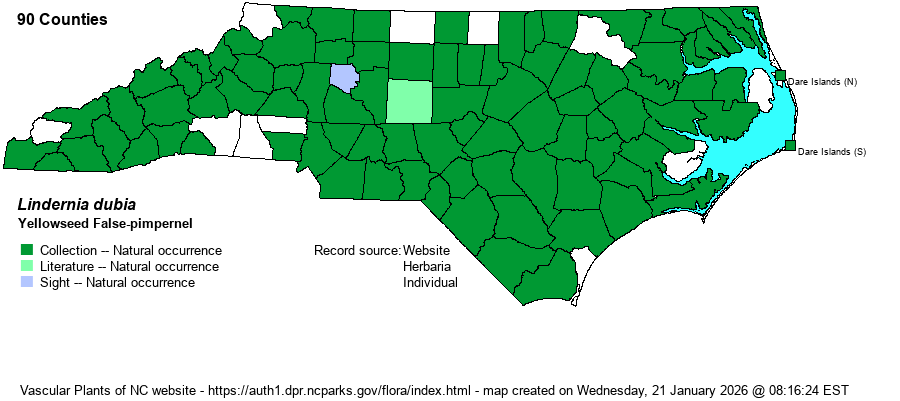| taxonName | relationship | relatedTaxonName | relatedTaxonRefText | relComments |
|---|
|
|
|
|
| Lindernia dubia | > | Lindernia dubia var. anagallidea | Gleason and Cronquist (1991) | |
| Lindernia dubia | > | Lindernia dubia var. anagallidea | Kartesz (1999) | |
| Lindernia dubia | > | Lindernia dubia var. anagallidea | | |
| Lindernia dubia | > | Lindernia dubia var. anagallidea | | |
| Lindernia dubia | > | Lindernia dubia var. anagallidea | Flora of Virginia | |
| Lindernia dubia | > | Lindernia dubia var. anagallidea | Wunderlin & Hansen Flora of Florida (3) | |
| Lindernia dubia | > | Lindernia dubia var. anagallidea | Fischer in Kadereit (2004). [see also Bonnaya and Torenia] | |
| Lindernia dubia | > | Lindernia dubia var. anagallidea | Fischer in Kadereit (2004). [see also Bonnaya and Torenia] | |
| Lindernia dubia | > | Lindernia dubia var. anagallidea | Fischer in Kadereit (2004). [see also Bonnaya and Torenia] | |
| Lindernia dubia | > | Lindernia dubia var. dubia | Gleason and Cronquist (1991) | |
| Lindernia dubia | > | Lindernia dubia var. dubia | Fernald (1950) | |
| Lindernia dubia | > | Lindernia dubia var. dubia | Gleason (1952) | |
| Lindernia dubia | > | Lindernia dubia var. dubia | Kartesz (1999) | |
| Lindernia dubia | > | Lindernia dubia var. dubia | | |
| Lindernia dubia | > | Lindernia dubia var. dubia | | |
| Lindernia dubia | > | Lindernia dubia var. dubia | Flora of Virginia | |
| Lindernia dubia | > | Lindernia dubia var. dubia | Wunderlin & Hansen Flora of Florida (3) | |
| Lindernia dubia | > | Lindernia dubia var. dubia | Fischer in Kadereit (2004). [see also Bonnaya and Torenia] | |
| Lindernia dubia | > | Lindernia dubia var. dubia | Fischer in Kadereit (2004). [see also Bonnaya and Torenia] | |
| Lindernia dubia | > | Lindernia dubia var. dubia | Fischer in Kadereit (2004). [see also Bonnaya and Torenia] | |
| Lindernia dubia | > | Lindernia dubia var. riparia | Fernald (1950) | |
| Lindernia dubia | > | Lindernia dubia var. riparia | Gleason (1952) | |
| Lindernia dubia | > | Lindernia dubia var. inundata | Fernald (1950) | |
| Lindernia dubia | > | Lindernia dubia var. inundata | Gleason (1952) | |
| Lindernia dubia | > | Lindernia dubia var. inundata | Kartesz (1999) | |
| Lindernia dubia | > | Lindernia dubia var. inundata | | |
| Lindernia dubia | > | Lindernia anagallidea | Fernald (1950) | |
| Lindernia dubia | > | Lindernia anagallidea | Gleason (1952) | |
| Lindernia dubia | > | Lindernia anagallidea | Godfrey and Wooten (1979, 1981) | |
| Lindernia dubia | > | Lindernia anagallidea | Fischer in Kadereit (2004). [see also Bonnaya and Torenia] | |
| Lindernia dubia | > | Lindernia anagallidea | Radford, Ahles, and Bell (1968) | |
| Lindernia dubia | > | Lindernia anagallidea | Flora of West Virginia | |
| Lindernia dubia | > | Lindernia dubia | Godfrey and Wooten (1979, 1981) | |
| Lindernia dubia | > | Lindernia dubia | Radford, Ahles, and Bell (1968) | |
| Lindernia dubia | > | Lindernia dubia | Flora of West Virginia | |
| Lindernia dubia | > | Lindernia dubia var. major | Fischer in Kadereit (2004). [see also Bonnaya and Torenia] | |
| Lindernia dubia | > | Lindernia dubia var. typica | Fischer in Kadereit (2004). [see also Bonnaya and Torenia] | |
| Lindernia dubia | > | Ilysanthes dubia | Small (1933, 1938) | |
| Lindernia dubia | > | Ilysanthes inequalis | Small (1933, 1938) | |
| Source: Weakley's Flora |

